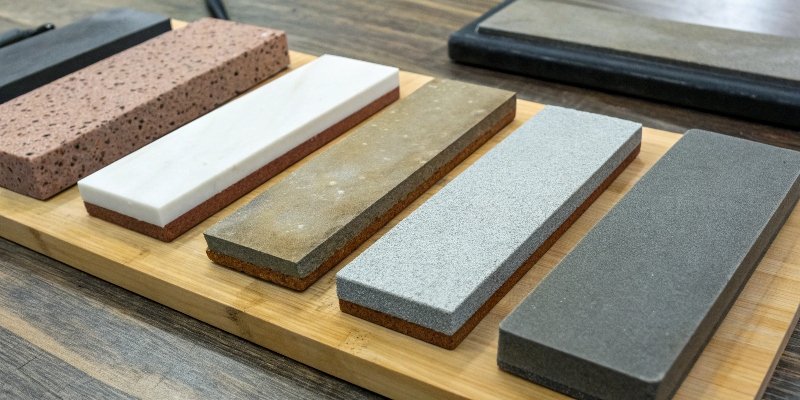
What is the best type of sharpening stone for kitchen knives?
Your kitchen knives are getting dull, making simple tasks like slicing a tomato a frustrating chore. A dull knife is a dangerous knife, but choosing the right sharpening stone restores its edge safely.
The best sharpening stone for most kitchen knives is a dual-grit synthetic whetstone, often with a #1000 grit side for general sharpening and a lower grit side for repairs. For ultimate sharpness on high-end blades, Japanese whetstones are superior. Diamond stones are best for very hard or ceramic knives.
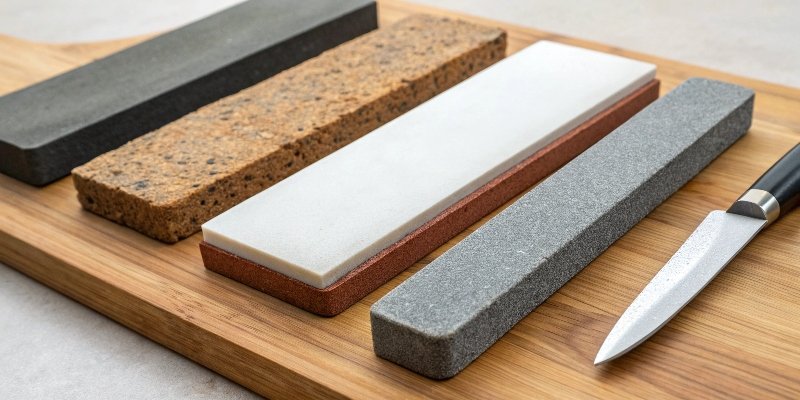
That simple answer gives you a great starting point, but the details really matter. The type of steel in your knife, how dull it is, and the kind of edge you want all influence the perfect choice. We need to look closer at the different types of stones, the meaning of "grit1," and what professionals trust in their kitchens. Let’s break it down so you can choose with confidence.
What is the best stone to sharpen kitchen knives?
You see all the options online: water stones, diamond plates, oil stones. It can be confusing, and this confusion can stop you from buying anything, leaving your knives dull and unsafe.
For most people, a synthetic water stone (whetstone) is the best choice. It balances cost and performance perfectly. Diamond stones are faster for very dull or hard steel knives, while traditional Japanese whetstones give the sharpest, most polished edge possible for high-end blades.
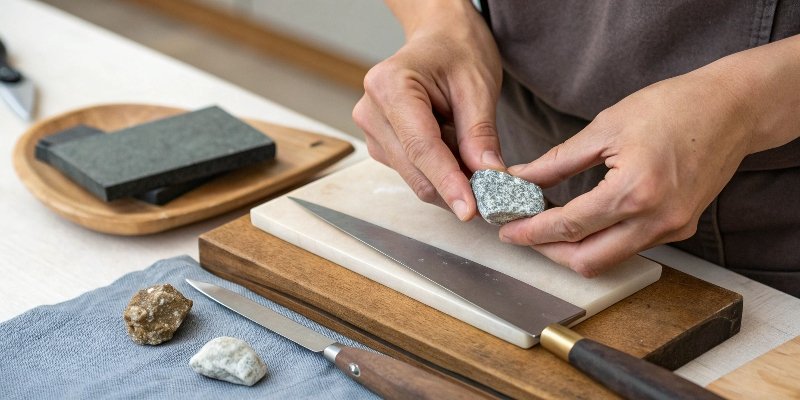
As a company that has spent nearly thirty years making abrasive tools, we know that the material doing the cutting is everything. The same principle applies whether you are grinding industrial parts or sharpening a kitchen knife. The right abrasive makes all the difference. Let’s look at the three main types you’ll encounter.
The Main Types of Stones
| Type | Key Features | Best For |
|---|---|---|
| Dual-Grit Synthetic | Affordable, uses water, often has two grits (e.g., #400/#1000). | Home kitchens, beginners, daily maintenance. |
| Japanese Whetstones | Produces a razor-sharp, mirror-finish edge. | High-end Japanese knives (Santoku, Gyuto). |
| Diamond Stones | Very fast cutting, long-lasting, works on hard materials. | Very dull knives, quick touch-ups, ceramic knives. |
Synthetic stones are the go-to for a reason. They cut efficiently and are easy to clean up since they only use water. Japanese whetstones are a more specialized version. They are often softer, which gives amazing feedback as you sharpen and creates that legendary sharp edge. Diamond stones are different; they have a metal plate coated with tiny diamonds. They remove material very quickly, which is great for repairing a damaged blade but can be too aggressive for fine-tuning if you’re not careful.
What grit stone is best for kitchen knives?
You see numbers like 400, 1000, and 6000 on sharpening stones, and it feels like a code. Choosing the wrong grit can either take forever to sharpen your knife or accidentally ruin it.
If you only buy one stone, make it a #1000 grit. This medium grit is perfect for regular maintenance and restoring a good edge. To fix a very dull knife, start with a #400 grit. For a razor-sharp, polished finish, use a #3000 to #8000 grit stone.
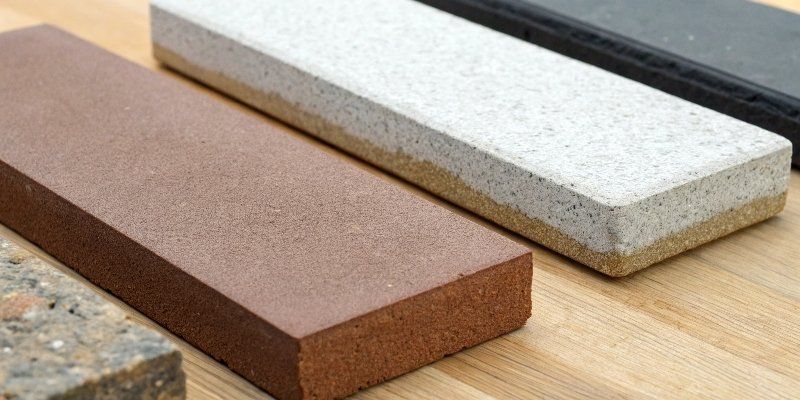
Understanding grit is simple. It’s just a measure of how coarse or fine the abrasive particles are. A lower number means larger particles, which remove metal faster. A higher number means smaller particles, which polish and refine the edge. In our factory, we use this principle every day, from coarse grinding wheels that shape metal to super-fine abrasives that polish it to a mirror.
Coarse Grits (Under #1000)
These stones are for serious repair work. If your knife has chips on the blade or is extremely dull, a coarse stone is where you start. A grit around #200 to #400 will reshape the edge quickly. But be careful. These stones remove a lot of metal, so you should only use them when necessary, not for routine sharpening.
Medium Grits (#1000 to #3000)
This is the most important range for kitchen knives2. A #1000 grit stone is the true workhorse. It has enough cutting power to sharpen a moderately dull knife in a reasonable amount of time without being overly aggressive. It creates a solid, sharp, and durable edge that is perfect for all everyday kitchen tasks. Most dual-grit stones include a #1000 grit side for this reason.
Fine Grits (Above #3000)
These are your finishing stones. After sharpening on a medium grit, you move to a fine stone to refine and polish the edge. A #3000 to #8000 grit stone will turn a sharp edge into a scary-sharp one. This step creates a mirror polish on the bevel of the knife, which not only looks amazing but also helps it glide through food with very little resistance. This is for perfectionists and those with high-end knives.
What do most chefs use to sharpen knives?
You want your knives to perform like a professional chef’s. But their tools and techniques can feel like a well-guarded secret, leaving you wondering how they achieve that perfect slice every time.
Most chefs rely on a couple of high-quality water stones. Their main tool is a medium #1000 grit whetstone for primary sharpening. Many also have a #3000-#6000 grit finishing stone for a razor-fine edge. For daily upkeep, they use a honing steel constantly.
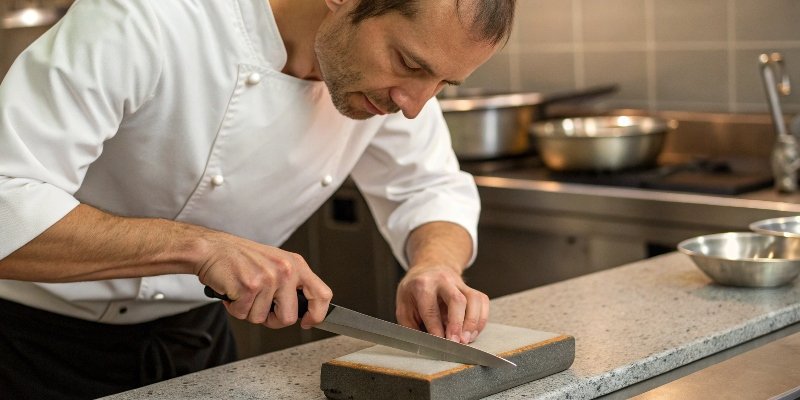
A professional chef’s knife is their most important tool, and they treat it that way. They don’t use complicated gadgets; they master the fundamentals with simple, effective tools. Their system is built on creating a great edge with stones and then maintaining that edge with daily honing. It’s a two-part process that anyone can learn.
The Chef’s Go-To Stone
The #1000 grit water stone, like a Shapton Pro3 or a King stone4, is the foundation. It’s what they use every week or two to bring a dull edge back to life. It’s fast enough to be efficient during a busy work week but fine enough to create a strong working edge.
The Polishing Step
For tasks that require extreme precision, like slicing fish for sashimi or making paper-thin vegetable garnishes, a refined edge is necessary. That’s where a high-grit polishing stone comes in. A chef will use a #5000 or #6000 grit stone to polish the edge to an incredible level of sharpness. This step makes the knife glide through food with almost no effort.
Daily Maintenance is Key
A sharpening stone creates a new edge. A honing steel5, which chefs use before every shift, does something different: it maintains the edge. It realigns the microscopic teeth of the blade that get bent during use. This daily practice keeps the knife feeling sharp for much longer, reducing the number of times it needs to be put on a stone.
How do you choose a sharpening stone?
Now you know about the different types of stones, grit levels, and professional setups. But you still have to make a final decision for your own knives, which can feel like a big step.
Choose your stone based on three things: your knife type, its dullness, and your sharpening goal. For typical kitchen knives, a dual-grit synthetic stone (#400/#1000) is a perfect start. For super hard steel or ceramic knives, get a diamond stone. For the absolute sharpest edge, get Japanese stones.
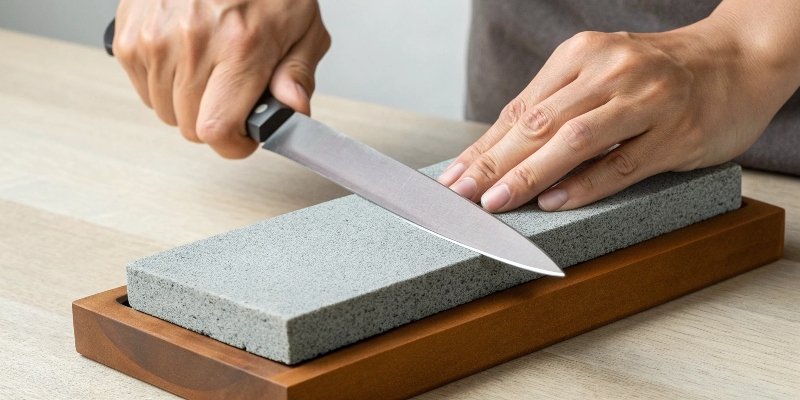
Let’s turn this into a simple decision. By answering the three questions below, you can pick the perfect sharpening stone with total confidence and get the exact results you are looking for.
1. What Kind of Knives Do You Have?
The type of steel in your knife is important. Most European or American knives (like Wüsthof or Henckels) are made of softer stainless steel. They are easy to sharpen on a standard synthetic whetstone. High-end Japanese knives or custom blades often use very hard carbon steel. These harder steels benefit from high-quality Japanese whetstones or even diamond stones6, like a DMT Dia-Sharp7, which cut hard materials more effectively. If you have ceramic knives, a diamond stone is your only option.
2. How Dull Are They?
Be honest about the state of your knives. Are they just struggling to slice a tomato, or do they have visible chips and can’t cut paper at all? If they are just a little dull, a medium #1000 grit stone is all you need. If they are in bad shape, you need a stone set that includes a coarse grit, like a #400, to repair the edge before you can sharpen it.
3. What’s Your Goal?
What level of sharpness are you trying to achieve? If you just want a reliable, sharp edge for daily cooking, a dual-grit synthetic stone is perfect. If you are an enthusiast who finds joy in a perfectly polished, razor-sharp blade for slicing delicate foods, then you should invest in a system with finishing stones, like a #5000 grit or higher.
Conclusion
Choosing the right stone is easy. A medium-grit water stone is a fantastic start for anyone. Match the stone type and grit to your specific knives and goals for a perfectly sharp blade.
-
Understanding grit is crucial for selecting the right sharpening stone for your knives. ↩
-
Find out which kitchen knives are essential for every home cook. ↩
-
Explore the features of Shapton Pro stones, favored by professional chefs. ↩
-
Learn about King stones and their effectiveness for sharpening kitchen knives. ↩
-
Understand the importance of honing steel in maintaining a knife’s edge. ↩
-
Learn how diamond stones can quickly sharpen very hard or ceramic knives. ↩
-
Find out how DMT Dia-Sharp stones excel in sharpening hard materials. ↩
Written by
leeon
You may also be interested in:

What is an angle grinder?
Are you confused by this powerful, versatile tool? You see it everywhere but are not sure what it does or if you need one. Getting
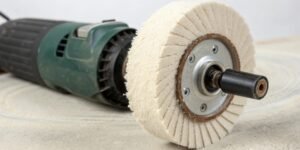
What is a buffing wheel used for?
Dull, scratched surfaces can ruin your products. This costs time and money. A buffing wheel is your tool to restore that perfect, professional finish everyone
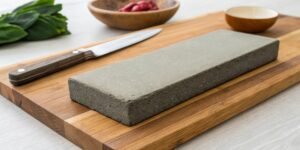
What is a good sharpening stone for my knives?
A dull knife is frustrating and can be unsafe. But with so many sharpening stones available, choosing the right one feels overwhelming. I will help

What belt grinder should a (beginner) knife maker own?
Starting knife making is exciting, but choosing the right grinder is overwhelming. The wrong one ruins projects and wastes money. This guide simplifies picking the

How do you cut welds with a grinder?
You have a rough weld that needs removing, but you’re worried about damaging the metal or getting hurt. Using an angle grinder correctly is the

Can I put a circular saw blade on a grinder?
You need to make a quick cut, and your angle grinder is right there. It’s tempting to try and fit a saw blade on it.
